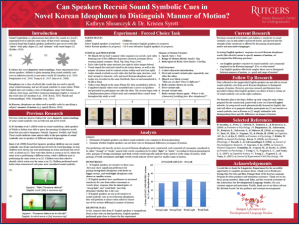Slusarczyk, Kathryn: Can Speakers Recruit Sound Symbolic Cues in Novel Korean Ideophones to Distinguish Manner of Motion?
Title: Can Speakers Recruit Sound Symbolic Cues in Novel Korean Ideophones to Distinguish Manner of Motion?
Name: Kathryn Slusarczyk
Major: Linguistics & Korean
School affiliation: Douglass Residential College, Honors College, School of Arts and Sciences
Programs: Honors College Capstone, Departmental Honors Thesis
Other contributors: Kristen Syrett
Abstract: Traditionally, linguists agree that the meaning of a word is only arbitrarily connected to what it sounds like. For instance, the sounds that make up the word “dog” don’t give any explicit indication as to what the word “dog” actually means. However, the phenomenon known as sound symbolism allows for sounds at a word’s segmental level to indicate some sense of a word’s meaning. Although we typically glean meaning from different cues, previous research on this phenomenon reveals that both adults and children can employ sound symbolism to determine meaning for unknown words. In Imai et al 2008, 4yr olds acquiring either English or Japanese demonstrated an ability to determine meaning for a set of novel sound symbolic Japanese verbs in a forced choice pointing task. Participants’ cross-linguistic ability to determine meaning from these phonological cues does not seem to be dictated only by the prevalence of sound symbolic words in a participant’s native language. The Korean language contains a class of words known as ideophones, similar to English adverbs, in which every ideophone follows a strict set of phonological rules that makes them all sound symbolic. The current study examines how English speakers and Korean speakers interpret a set of novel Korean ideophones in a forced choice pointing task. When shown two videos of the same action being performed with different speed and/or range of motion, participants are given a novel ideophone and asked to match it to either variation. We expected to see that English speaking adults and children, while unfamiliar with Korean phonological rules, could determine meaning from sound symbolic cues encoded in these novel Korean ideophones. However, we found that English speakers were unable to determine meaning from these cues in the current study. Though these results suggest that speakers are not sensitive to sound symbolic cues consistent with the phonology of a non-native language, we consider how a modified task may yield different results.
